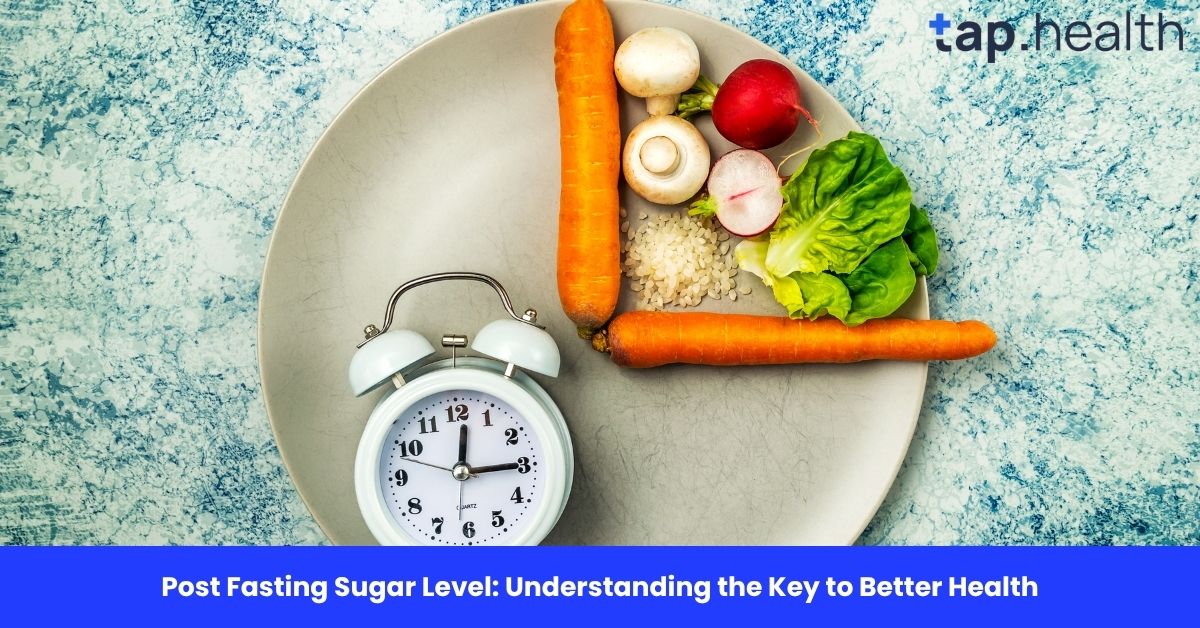Understanding your blood sugar levels is crucial for overall health, particularly when it comes to managing conditions like diabetes or prediabetes. One key measurement that is often overlooked is the post fasting blood sugar level, which refers to the glucose level in your blood after a period of fasting, typically measured after an overnight fast.
In this article, we’ll dive deep into what post fasting sugar levels are, why they matter, and how they are used to diagnose and manage diabetes. We’ll also cover how to maintain healthy blood sugar levels, common myths, and expert advice on preventing high blood sugar. Whether you have diabetes or just want to ensure your blood sugar levels are normal, this guide will help you understand everything you need to know about post fasting sugar levels.
What is Post Fasting Blood Sugar Level?
Post fasting blood sugar level refers to the blood glucose level measured after you have not eaten or drunk anything except water for at least 8–12 hours. Typically, this is done after an overnight fast, meaning you don’t eat anything after dinner and have the blood test in the morning before you have breakfast.
Why Is It Important?
After fasting, your blood sugar level should naturally be at its baseline. This test helps doctors understand how your body processes glucose in a fasting state, which is important for diagnosing diabetes, prediabetes, and other health conditions related to blood sugar regulation. It provides insight into how well your pancreas is functioning and how effectively your body uses insulin.
Normal Post Fasting Sugar Levels
Understanding what constitutes normal post fasting blood sugar levels is essential for anyone monitoring their health, especially individuals at risk for diabetes. The following guidelines can help you understand what is considered a normal, prediabetic, or diabetic range:
Normal Range for Post Fasting Blood Sugar:
- 70–99 mg/dL (3.9–5.5 mmol/L): This is the ideal range for healthy individuals. If your post fasting sugar level falls within this range, it suggests that your body is processing glucose efficiently.
Prediabetes:
- 100–125 mg/dL (5.6–6.9 mmol/L): If your blood sugar levels are in this range, you may have prediabetes. Prediabetes is a warning sign that your blood sugar levels are higher than normal but not high enough to be diagnosed as diabetes. It is crucial to make lifestyle changes, including improving your diet and increasing physical activity, to prevent the progression to type 2 diabetes.
Diabetes:
- 126 mg/dL (7.0 mmol/L) or higher: This level typically indicates diabetes, especially if confirmed by two or more tests. If your fasting blood sugar level falls within this range, it’s essential to consult a healthcare provider for further evaluation and treatment.
What Happens If Your Post Fasting Sugar Is Too High?
When your post fasting sugar level is higher than normal, it indicates that your body is struggling to regulate blood glucose effectively. Over time, this can lead to serious complications such as:
- Type 2 Diabetes: If blood sugar levels remain consistently high, your body may become resistant to insulin, leading to type 2 diabetes.
- Heart Disease: High blood sugar levels contribute to damage to the blood vessels, increasing the risk of cardiovascular diseases.
- Nerve and Kidney Damage: Persistent high blood sugar levels can lead to nerve damage (neuropathy) and kidney damage (nephropathy).
- Vision Problems: High blood sugar can damage the blood vessels in the eyes, leading to diabetic retinopathy, which can cause blindness if left untreated.
How to Measure Post Fasting Sugar Level
To accurately measure post fasting blood sugar levels, the following steps are typically followed:
- Fast for 8–12 Hours: Begin by fasting for at least 8 hours (usually overnight). Only water is allowed during this period.
- Blood Test: The blood test is usually performed in the morning before you eat or drink anything other than water. It can be done at a clinic or through home glucose meters.
- Result Analysis: After the blood sample is drawn, the glucose level will be measured. The result will fall into one of the categories mentioned earlier (normal, prediabetes, or diabetes).
Why is Fasting Important for This Test?
Fasting allows your body to clear any sugar from your system, providing a more accurate baseline reading of how well your body regulates glucose without the influence of food. Eating before the test can skew the results and make it harder to detect underlying issues like insulin resistance or early-stage diabetes.
How to Maintain Healthy Post Fasting Sugar Levels?
Maintaining healthy post fasting blood sugar levels is key to reducing the risk of diabetes and its complications. Here are some steps you can take to keep your blood sugar levels within the normal range:
1. Eat a Balanced Diet
Focus on a diet rich in whole grains, lean proteins, healthy fats, and plenty of vegetables. Avoid sugary foods and refined carbohydrates, which can cause blood sugar spikes.
2. Exercise Regularly
Physical activity increases insulin sensitivity, which means your body uses glucose more efficiently. Aim for at least 30 minutes of moderate exercise most days of the week.
3. Maintain a Healthy Weight
Excess weight, especially abdominal fat, can increase the risk of insulin resistance. Achieving and maintaining a healthy weight can help improve your blood sugar control.
4. Reduce Stress
Chronic stress increases levels of cortisol, a hormone that can raise blood sugar. Practicing stress management techniques like yoga, deep breathing, and mindfulness can help.
5. Get Enough Sleep
Poor sleep can affect how your body processes glucose. Aim for 7-9 hours of sleep per night to help regulate blood sugar.
6. Monitor Your Blood Sugar Levels
If you are at risk of diabetes or already diagnosed with the condition, regular monitoring of your blood sugar levels can help you make necessary adjustments to your diet and lifestyle.
Read this : Is a 105 mg/dL blood sugar level dangerous?
Myths and Facts About Post Fasting Blood Sugar
Myth 1: You Only Need to Test Your Blood Sugar if You Have Diabetes
Fact: Even if you don’t have diabetes, checking your blood sugar levels can help catch any abnormalities early, especially if you have risk factors such as obesity, family history, or a sedentary lifestyle.
Myth 2: High Post Fasting Blood Sugar is Only a Concern for People with Diabetes
Fact: High post fasting blood sugar levels can also indicate prediabetes, which can be managed and reversed with lifestyle changes, including better diet and regular physical activity.
Myth 3: I Can Skip Testing if My Blood Sugar is Fine in the Morning
Fact: Fasting blood sugar levels do not always provide the full picture. Postprandial testing (after meals) is important to check how your body processes glucose after eating.
Key Takeaways
- Post fasting blood sugar levels are an important measure of how your body processes glucose after fasting. Normal levels should be between 70–99 mg/dL.
- Elevated post fasting sugar levels can indicate prediabetes or diabetes, which can lead to serious health complications if not managed properly.
- Regular monitoring, a balanced diet, exercise, and stress management are all key to maintaining healthy post fasting sugar levels and preventing complications like heart disease and nerve damage.
- Early detection of high blood sugar levels can help you make necessary lifestyle changes and prevent the onset of type 2 diabetes.
Frequently Asked Questions (FAQs) on Post Fasting Sugar Level
Q1: What is a normal post fasting blood sugar level?
A1: A normal post fasting blood sugar level is between 70–99 mg/dL (3.9–5.5 mmol/L). Anything above this may indicate prediabetes or diabetes.
Q2: How is post fasting blood sugar tested?
A2: Post fasting blood sugar is tested by fasting for 8–12 hours, then having a blood sample taken to measure glucose levels. It’s best to do this test in the morning, before eating.
Q3: Can I eat before a post fasting blood sugar test?
A3: No, you should fast for at least 8 hours before the test. Only water is allowed during this period to get accurate results.
Q4: Why does my post fasting blood sugar matter?
A4: Post fasting blood sugar helps determine how well your body processes glucose after not eating. It is used to diagnose conditions like prediabetes and diabetes.
Q5: What if my post fasting blood sugar is high?
A5: High post fasting blood sugar could indicate prediabetes or diabetes. It’s important to consult a doctor to evaluate your condition and make lifestyle changes.
Q6: Can I manage high post fasting blood sugar without medication?
A6: In many cases, high blood sugar can be managed through diet, exercise, and stress management. However, if your blood sugar levels are high, medications may also be required as prescribed by your doctor.
Q7: What are the risks of high post fasting blood sugar?
A7: High post fasting blood sugar can lead to complications such as heart disease, nerve damage, and kidney disease, especially if it’s not managed over time.
Q8: How often should I check my post fasting blood sugar?
A8: If you’re at risk of diabetes, it’s a good idea to check your blood sugar regularly, as advised by your healthcare provider. For those with diabetes, frequent monitoring may be required.



